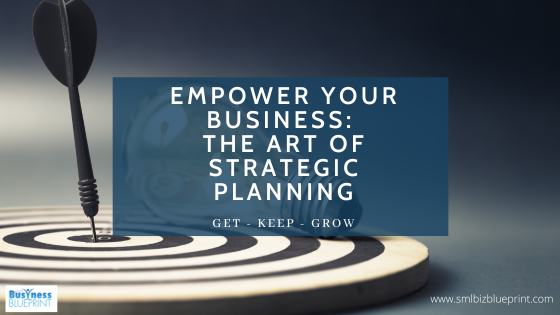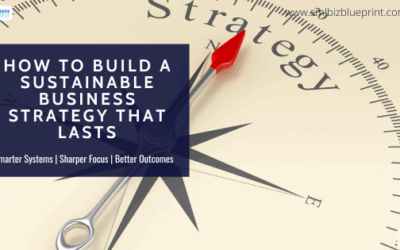As a small to medium-sized business owner, you know that success doesn’t happen by chance. It requires careful planning, a clear vision, and actionable strategies.
Strategic planning is the compass that guides your business towards long-term success and growth.

This article will explore the fundamentals of strategic planning, step-by-step implementation, and how it can pave the way for a prosperous future.
In today’s dynamic and competitive business landscape, it’s crucial to have a roadmap for the future.
Strategic planning defines your business’s vision, mission, and long-term goals while considering internal strengths, weaknesses, and external opportunities and threats.
By effectively understanding and implementing strategic planning, you can navigate uncertainties, make informed decisions, and stay ahead in the market.
I. The Fundamentals of Strategic Planning
At the heart of every successful strategic plan lies a clear and compelling vision that defines the company’s aspirations.
The vision is a guiding star, inspiring stakeholders, employees, and customers. Alongside the vision, a well-crafted mission statement communicates the purpose and values of your business.
These fundamental elements provide a solid foundation upon which strategic planning is built.
II. Conducting a SWOT Analysis
A crucial step in strategic planning is the SWOT analysis.
This analysis identifies your business’s internal strengths and weaknesses and assesses external opportunities and threats. Understanding these factors lets you capitalise on strengths, address weaknesses, seize opportunities, and mitigate threats.
A practical example is how a retail business can leverage its strong customer loyalty (strength) to expand into new markets (opportunity) while simultaneously improving supply chain inefficiencies (weakness) and facing increased competition (threat).
III. Setting SMART Goals
Goals play a pivotal role in strategic planning.
Strategic goals should be SMART – Specific, Measurable, Achievable, Relevant, and Time-bound.
Setting SMART goals provides a clear direction and allows you to measure progress effectively.
For instance, if you are in the software development industry, a SMART goal would be to increase your market share by 15% in the next fiscal year by launching two innovative products and expanding your sales team.

IV. Environmental Scanning
The business environment is ever-changing, with new trends, technologies, and market forces continuously emerging.
Environmental scanning involves monitoring and analysing these external factors to identify opportunities and potential threats.
Regular environmental scans allow you to adapt your strategic plan to stay relevant and competitive.
An example of environmental scanning is a solar energy company recognising the growing demand for renewable energy sources and altering its strategic focus to capitalise on this emerging trend.
V. Crafting Strategies and Action Plans
Once you have completed the SWOT analysis and environmental scanning, it’s time to craft specific strategies and action plans.
These strategies are the pathways that lead you from your current position to your desired future state. Action plans break down the strategies into actionable steps, assign responsibilities, and set deadlines.
For instance, a hospitality business aiming to expand internationally could devise a strategy to partner with local travel agencies in target markets and create an action plan detailing the steps, deadlines, and the teams responsible for the implementation.
VI. Implementation and Execution
Strategic planning is futile without effective implementation and execution. Many businesses face challenges in this phase, such as resistance to change, lack of resources, or unforeseen obstacles.
Flexibility and adaptability are crucial during implementation. Regular reviews, progress tracking, and communication are essential to ensure everyone is aligned and on track.
An illustrative example is an e-commerce startup successfully executing its strategy of improving customer experience by launching a user-friendly mobile app and streamlining the checkout process.

VII. Monitoring and Evaluation
Monitoring and evaluation are vital to gauge the success of your strategic planning efforts.
Key performance indicators (KPIs) help track progress toward goals and objectives. Regular evaluations allow you to identify what’s working well and what needs adjustment.
An example is a healthcare provider measuring the patient satisfaction rate post-implementation of a new service to assess the impact and identify areas for improvement.
VIII. Employee Engagement and Communication
Engaging employees throughout the strategic planning process is crucial for successful execution. Employees who understand and believe in the strategic goals are more likely to contribute effectively to their achievement.
Transparent and effective communication channels foster alignment and ensure everyone works towards the same vision.
For example, a manufacturing company may hold regular town hall meetings to communicate strategic updates, seek employee input, and address concerns.
IX Overview
Strategic planning provides businesses with a clear sense of direction and purpose.
Defining key goals, targets, or outcomes establishes a roadmap for your business’s success.
This allows you to allocate your resources efficiently and effectively, ensuring that your time, budget, and efforts are channelled towards achieving those crucial objectives. With a strategic plan, your company can focus on what truly matters, avoiding distractions and making informed decisions that align with your long-term vision.
This streamlined approach fosters a sense of unity among employees, as everyone works towards a shared mission, empowering the entire organisation to move forward with a unified purpose.

X. Case Studies of Successful Strategic Planning
Case Study: TechGenius – Pioneering Disruptive Innovation
TechGenius, a leading technology company, faced fierce competition and a saturated market.
They embarked on a strategic planning journey to overcome these challenges and foster future growth. Their vision was to become the industry leader in disruptive innovation.
Through a SWOT analysis, they identified their core strengths in research and development and acknowledged the potential of entering emerging markets. TechGenius set a SMART goal to launch three groundbreaking products within two years.
They successfully achieved their goals and transformed the tech landscape by fostering a culture of innovation and collaboration.
Case Study: EcoHome – Sustaining Environmental Impact
EcoHome, a sustainable construction company, recognised the increasing demand for eco-friendly solutions and strategic planning’s role in achieving its mission.
Their vision was to build environmentally responsible communities without compromising quality. During their SWOT analysis, they identified their expertise in green building practices as a strength and seized the opportunity to expand into the commercial construction sector.
With SMART goals in place, EcoHome implemented strategies to enhance supplier partnerships, invest in renewable energy solutions, and provide educational workshops.
Their commitment to sustainability attracted new clients and generated positive social and environmental impact.
FAQs
What is strategic planning, and why is it essential for business success?
Strategic planning is defining a business’s long-term goals and creating a roadmap to achieve them. It is essential for success as it helps businesses align their actions with their vision, anticipate challenges, and seize opportunities, maximising their growth potential.
How do I conduct a SWOT analysis for my business?
To conduct a SWOT analysis, identify your business’s strengths and weaknesses internally and opportunities and threats externally. Gather insights from key stakeholders, customers, and industry trends. Analyse the data to identify areas of improvement and potential growth opportunities.
Why are SMART goals crucial in strategic planning?
SMART goals provide clarity and focus, ensuring that objectives are Specific, Measurable, Achievable, Relevant, and Time-bound. They create a sense of direction, help measure progress, and motivate teams to achieve a common purpose.
What are some common challenges in implementing strategic plans, and how can I overcome them?
Common challenges include resistance to change, lack of resources, and inadequate communication. Overcome these hurdles by involving employees in planning, securing necessary resources, and maintaining open communication channels to address concerns.
How often should I review and update my strategic plan to stay relevant in the market?
Regular reviews are essential to adapt to changing market dynamics. Annually or semi-annually, revisit your strategic plan, assess progress, and make necessary adjustments to ensure it remains aligned with your business’s objectives.
How can employee engagement impact the success of strategic planning?
Engaged employees are more invested in the success of the company and its strategic goals. Involving them in the planning process fosters ownership, commitment, and innovative contributions, leading to successful execution.
What are some strategies for effective communication during the strategic planning process?
Effective communication includes clear and transparent dissemination of strategic goals, regular updates on progress, and encouraging two-way communication to gather employee feedback and insights.
Conclusion
Strategic planning is the driving force behind future business success. You can steer your company towards its envisioned future by carefully analysing your business, setting SMART goals, crafting actionable strategies, and executing them effectively.
Embrace strategic planning as a continuous process, adapting to changing environments and staying ahead in the ever-evolving market.




